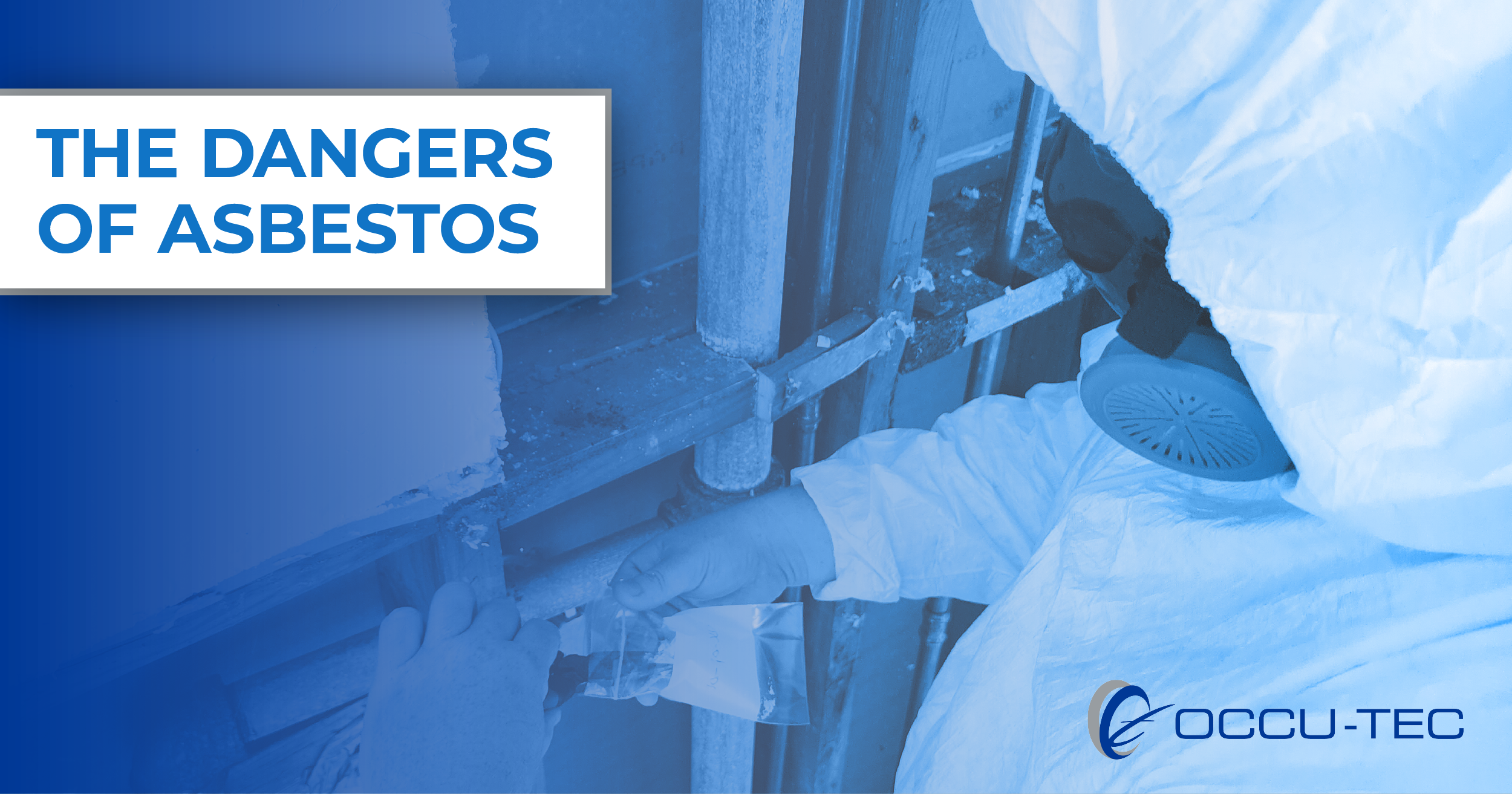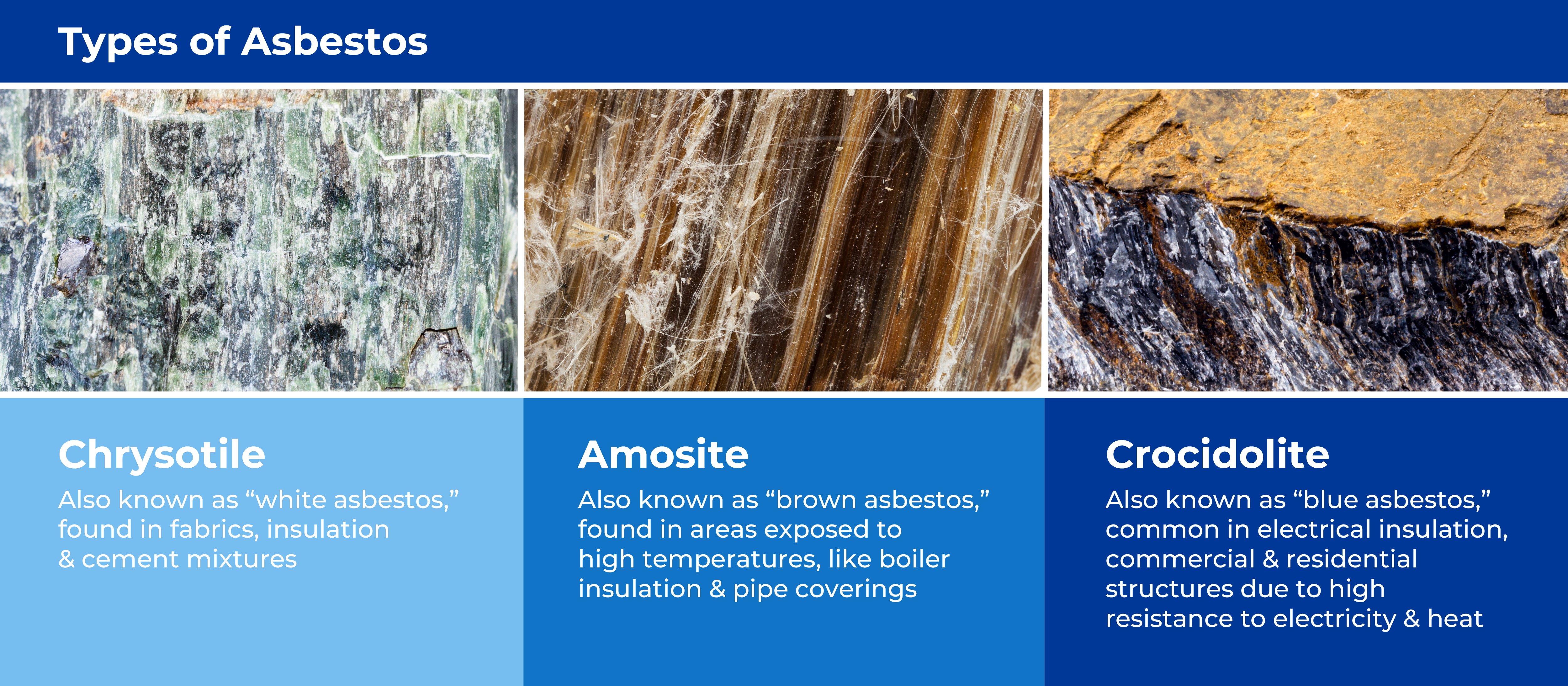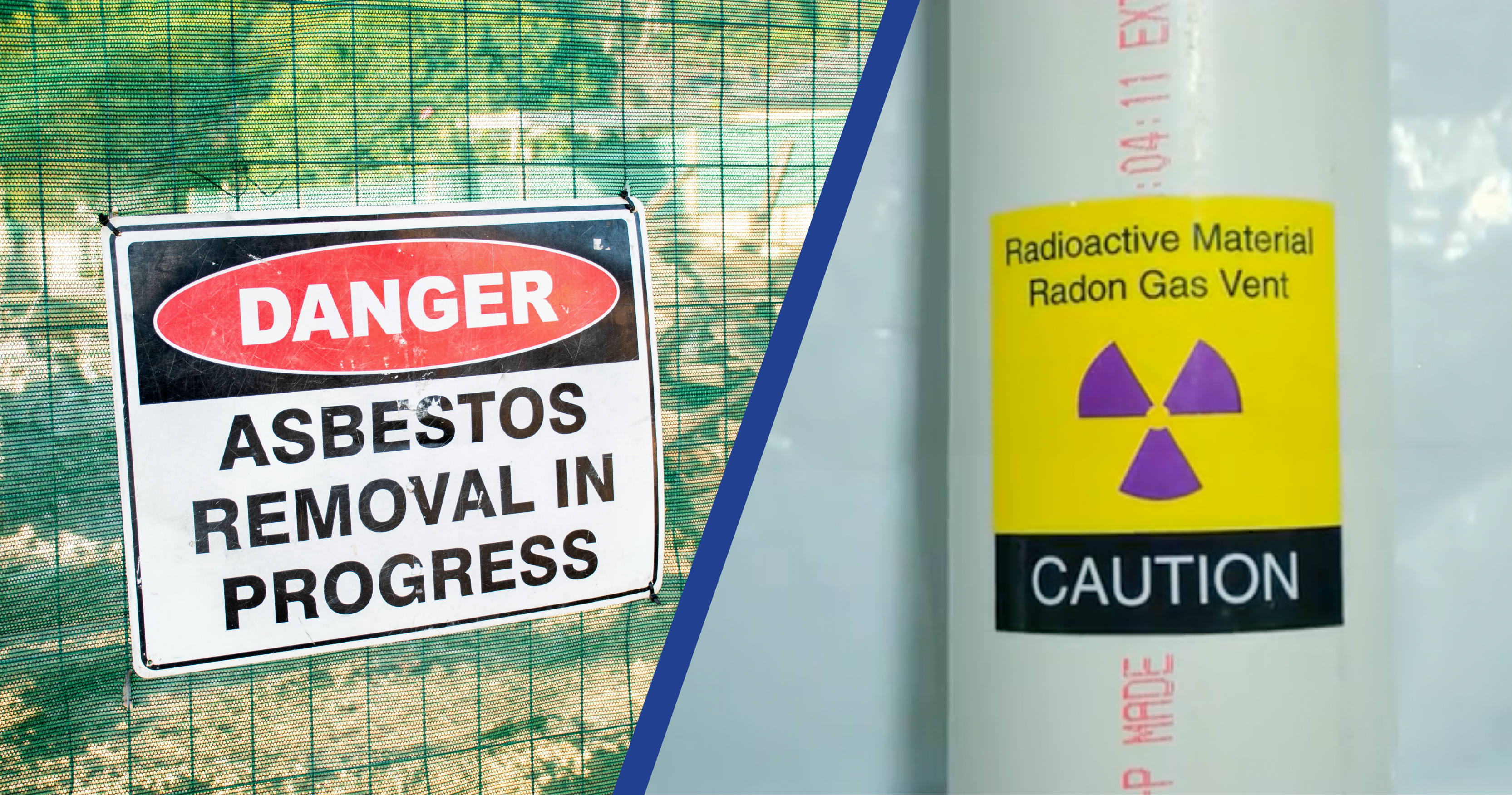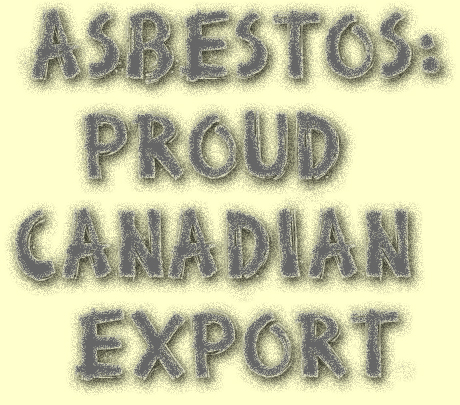7 min read
The Dangers of Asbestos: Understanding Its Risks and How To Address Them
 OCCU-TEC, Inc.
:
Nov 22, 2023
OCCU-TEC, Inc.
:
Nov 22, 2023

Imagine an era when builders and architects celebrated a material with the extraordinary ability to resist fire and provide insulation against the most relentless natural elements. In the late 19th century, asbestos emerged as a construction wonder due to its economic advantages and exceptional adaptability. However, a dangerous secret was lurking beneath its apparent utility.
In this exploration, we shed light on the historical reign asbestos held in construction and the ominous health risks it conceals. We’ll examine asbestos testing, identification, and the crucial art of safe removal, all aimed at ensuring your well-being and the well-being of those around you.
What is Asbestos?
Asbestos is a collective term for naturally occurring minerals that boast a unique blend of heat resistance and durability. Within this family, several distinct types of asbestos fibers exist, each with its characteristic properties. Some examples are summarized below:
-
Chrysotile, commonly referred to as white asbestos, stands out for its remarkable flexibility, making it a versatile choice for various applications. Due to its pliability, chrysotile fibers could be easily woven into fabrics, incorporated into insulation materials, and added to textile components and adhesives.
-
Amosite, or brown asbestos, is highly regarded for its extraordinary heat resistance. This property made it particularly valuable in environments where exposure to high temperatures was a constant concern, such as boiler insulation and pipe coverings.
-
Crocidolite, often referred to as blue asbestos, gained its reputation for exceptional insulating properties. Its resistance to electricity and heat made it an ideal candidate for electrical insulation and electrical components. Additionally, its insulation capabilities were highly sought after in both commercial and residential structures.

These qualities made asbestos an appealing choice in construction, where it found its way into a multitude of building materials. Its fire-retardant capabilities and excellent insulation made it a sought-after addition to countless structures, safeguarding them against the ravages of flames and environmental extremes. However, as we now know, this seemingly miraculous mineral conceals a dark side – the looming health risks associated with exposure to its microscopic fibers.
The Risks of Asbestos Exposure
The risks of asbestos exposure are far-reaching and deadly, encompassing diseases with life-altering consequences. The extended latency period, during which diseases may remain dormant, emphasizes the enduring dangers. With prevalent exposure and alarming statistics and research findings, it is clear that asbestos-related diseases are a pressing global health concern that demands both awareness and action to protect public health and safety.
The Looming Health Hazards of Asbestos Exposure
Asbestos exposure is synonymous with a host of debilitating health conditions, primarily affecting the respiratory system. The three chief diseases linked to asbestos exposure are asbestosis, lung cancer, and mesothelioma.
-
Asbestosis, a progressive lung disease, is characterized by severe scarring of lung tissue, leading to breathing difficulties.
-
Lung cancer, a malignant growth of lung cells, is a well-established consequence of asbestos exposure, and the risk is significantly heightened for those who smoke.
-
Mesothelioma, a rare and aggressive cancer that affects the lining of the lungs, heart, or abdomen, is often directly attributed to asbestos exposure.
The Latency Period: A Silent Menace
One of the most insidious aspects of asbestos-related diseases is their extended latency period, which can stretch over several decades. This means that individuals exposed to asbestos may not display symptoms or become ill until many years later. This prolonged delay between exposure and the onset of disease underscores the enduring risks associated with even minimal or past exposure. It's a stark reminder that the consequences of asbestos exposure can quietly linger, making early prevention and intervention all the more critical.
Prevalence and Research Findings
Studies and research findings consistently highlight the widespread impact of asbestos exposure. For example, research indicates that approximately 125 million people worldwide continue to face occupational exposure to asbestos, while countless others encounter environmental exposure due to the presence of asbestos in buildings and materials.
Furthermore, statistics reveal a somber reality – asbestos-related diseases claim thousands of lives each year, and these numbers are projected to rise. EWG Action Fund calculated that 12,000 to 15,000 Americans a year die from asbestos-related diseases.
Is Asbestos Still In Materials Today?
The short answer: Yes. However, on March 18, 2024, the U.S. Environmental Protection Agency (EPA) announced that a ban has been implemented on the use of chrysotile asbestos, which is the most common form of asbestos used or imported into the U.S. This monumental step brings us closer to being able to say “no,” and finish the efforts to ban asbestos in the U.S., which started over 30 years ago.
Asbestos, a known carcinogen with serious health implications, and specifically chrysotile asbestos, can be found in products including asbestos diaphragms, gaskets, brake blocks, aftermarket automotive brakes and linings, flooring materials, roofing materials, drywall and joint compounds, ceiling tiles, mastics and adhesive, and many more.
Raw chrysotile asbestos was still being imported into the U.S. as recently as 2022, primarily used by the chlor-alkali industry. The EPA’s ban on the import of this asbestos for chlor-alkali use impacts eight facilities in the U.S., which produce chlorine and sodium hydroxide using asbestos diaphragms, that must over the next five years transition to new technology to produce their products.
While the new ruling targets the chlor-alkali industry, the ruling also bans the use of sheet gaskets, oilfield brake blocks, aftermarket automotive brakes and linings, other vehicle friction products and gaskets.
How to Test for Asbestos
Understanding the importance of asbestos testing is the first crucial step toward ensuring safety within these structures.
Significance of Asbestos Testing
Asbestos poses a grave health threat when its microscopic fibers become airborne – a perilous exposure that can lead to severe respiratory conditions. Identifying asbestos-containing materials (ACMs) is a regulatory requirement for schools under AHERA and for demolition and renovation. It’s also a moral imperative to safeguard the well-being of occupants.
Different Methods of Asbestos Testing
Various methods exist for asbestos testing, each tailored to specific circumstances and requirements. Understanding these testing methods allows property owners to select the most appropriate approach based on their needs.
-
Bulk material sample collection, one of the most common approaches, involves carefully gathering samples of suspected ACMs and sending them to accredited laboratories for analysis. These labs utilize specialized techniques to determine the presence and concentration of asbestos fibers, providing a clear verdict on the material's safety or hazard.
-
Air monitoring is employed to assess the airborne asbestos levels for evaluation of occupational exposure, if a suspect fiber release has occurred, or if abatement clearance has been achieved.
The Role of Certified Asbestos Inspectors
Certified asbestos inspectors possess the expertise and qualifications required to conduct thorough assessments and inspections. They not only identify ACMs but also assess their condition. With the help of management planners and project designers, they can assess risk levels and the necessary steps for safe management or removal. Their knowledge and experience are instrumental in ensuring the accuracy of the testing process and guiding property owners toward effective solutions to address potential asbestos hazards.
Where Can Asbestos Be Found?
Asbestos can be found in common building materials. Identifying and managing asbestos in these areas is essential for maintaining a safe and healthy environment for building occupants. Vigilance, professional testing, and caution when disturbing potential ACMs are the key to mitigating the risks associated with this hidden threat. Common areas include insulation, roofing materials, pipes, and boiler insulation. However, asbestos can also lurk in less-expected places. These areas include:
-
Vinyl Flooring: Older vinyl flooring, frequently installed in commercial buildings, may contain asbestos fibers. This poses a hidden danger, especially during renovation or removal. Professional testing is of paramount importance before undertaking any work involving such flooring. Disturbing asbestos-laden vinyl can release dangerous fibers into the air, potentially endangering the health of building occupants.
-
Textured Paints: Popular for their decorative and acoustic properties, textured paints once commonly contained asbestos. This historical use raises concerns when renovating or repainting surfaces. Disturbing textured paint, especially in older buildings, can release asbestos fibers into the environment.
-
Acoustic Ceilings: Also known as "popcorn ceilings," these were once created using asbestos-containing materials. The textured finish of these ceilings concealed asbestos, presenting an unsuspecting risk to building occupants. While the use of asbestos in these ceilings has significantly declined, older properties may still have them. Careful examination and professional testing are necessary to determine the presence of asbestos, ensuring the safety of those residing or working within these spaces.

Asbestos Report for Schools and Commercial Property
An asbestos report is a vital tool for schools and commercial property management, serving to identify and assess asbestos-containing materials (ACMs). This report is a crucial step in ensuring occupant safety and regulatory compliance.
Purpose and Importance of an Asbestos Report
The asbestos report is integral for understanding and managing asbestos risks in commercial properties. It identifies ACM locations, assesses their condition, and offers recommendations for management or removal. This document equips property owners and managers with the necessary information to make informed decisions regarding asbestos mitigation.
Content and Format of the Asbestos Report
An asbestos report includes detailed information about the identified ACMs, their condition (whether friable or non-friable), and associated risk levels. It also provides guidance on how to manage or remove these materials, along with cost estimates and timelines. A well-structured report ensures property stakeholders have actionable insights for asbestos risk mitigation.
Ongoing Re-Inspections and Updates
K-12 school properties are dynamic, requiring periodic re-inspections and updates to the asbestos report. As materials deteriorate or undergo changes, the status of ACMs can evolve. Regular re-inspections and report updates help school district leaders adapt to changing conditions, maintain compliance, and protect occupants from asbestos exposure risks.
Commercial Asbestos Removal
Commercial asbestos removal is not an option; it's a crucial obligation for the safety and well-being of those within your commercial space. Professional asbestos removal services ensure compliance with local regulations and guidelines, while the abatement process, comprising containment, removal, proper disposal, and air monitoring, guarantees a safe and effective resolution to the asbestos threat. By prioritizing these measures, you not only protect your business but also demonstrate your commitment to creating a safe and healthy environment for everyone involved.
The Significance of Professional Asbestos Removal Services
When it comes to asbestos removal in commercial properties, the stakes are high, and the risks are grave. Professional asbestos removal services are not just an option but a necessity. Trained experts possess the knowledge, experience, and equipment to manage the removal of ACMs safely and effectively. Their proficiency minimizes the potential for asbestos fiber release and contamination, safeguarding the health and well-being of occupants. It is a responsible choice that protects both your business and the people it serves.
Compliance with Local Regulations and Guidelines
Asbestos removal is not an endeavor to be taken lightly; it is subject to strict local regulations and guidelines. Compliance is not just a legal obligation but an ethical responsibility. Professional asbestos removal services are well-versed in these regulations and ensure that the removal process adheres to all stipulated requirements. This commitment to compliance not only safeguards the environment but also protects against potential legal repercussions, ensuring the responsible management of asbestos within your commercial space.
The Asbestos Abatement Process
The asbestos abatement process consists of multiple steps, each designed to minimize exposure and contamination. It typically begins with proper containment, creating a sealed environment to prevent the spread of asbestos fibers. During removal, certified professionals carefully extract the ACMs using specialized equipment and techniques. The removed materials are then securely packaged and disposed of in accordance with regulatory standards. This meticulous approach guarantees the safe and responsible disposal of asbestos, reducing the risk of future exposure.
OCCU-TEC: 40 Years of Empowering EH&S Solutions and Tackling Asbestos Risks
In today's fiercely competitive landscape, as businesses and public agencies increasingly scrutinize their workplace and operational practices to mitigate potential losses, you need a versatile and multidisciplinary organization like OCCU-TEC to serve as a trusted partner for expert advice and technical support.
Together, let us remain vigilant, equipped with knowledge to create spaces that are not only efficient and productive but, above all, safe and healthy for all who inhabit them. Contact us today to take the first step towards a safer, healthier, and more productive space.


